Australian Colonization: Aboriginal History and Culture Analysis
VerifiedAdded on 2022/09/25
|8
|1900
|25
Essay
AI Summary
This essay provides a comprehensive overview of Australian colonization, focusing on its impact on Aboriginal and Torres Strait Islander peoples. It begins by exploring the pre-colonization history of these groups, detailing their cultures, languages, and societal structures, including the roles of Aboriginal and Torres Strait Islander societies before colonization. The essay then examines the process of colonization, highlighting the devastating effects on Aboriginal life, including population decline, loss of land, and cultural disruption. It analyzes the issues faced by Indigenous Australians, such as economic disparities and social injustices. The essay also discusses the Uluru Statement from the Heart, its call for recognition in the Australian constitution, and its proposals for a First Nations Voice and a Makarrata Commission. The paper concludes by emphasizing the lasting impact of colonization and the importance of understanding the historical context to address contemporary issues, and the cultural and perspective of native people of Australia before and after the period of Colonization.
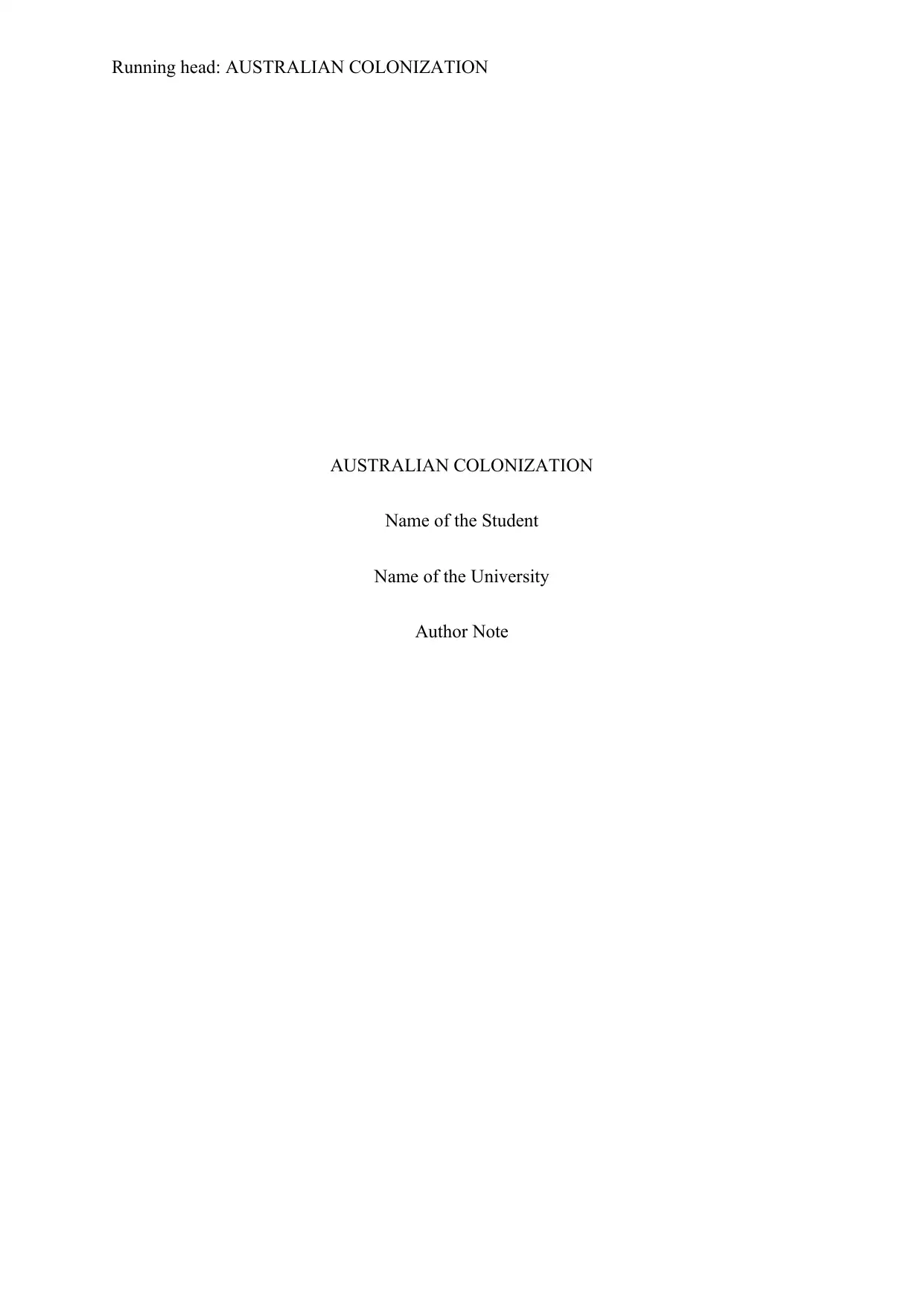
Running head: AUSTRALIAN COLONIZATION
AUSTRALIAN COLONIZATION
Name of the Student
Name of the University
Author Note
AUSTRALIAN COLONIZATION
Name of the Student
Name of the University
Author Note
Paraphrase This Document
Need a fresh take? Get an instant paraphrase of this document with our AI Paraphraser

1AUSTRALIAN COLONIZATION
INTRODUCTION
The period 1788 can be marked as the period of Australian Colonization. The past
story of Aboriginal and Torres Strait Islander has an important influence on past as well as
recent generations of the above stated Islander individuals (Lowe and Yunkaporta 2013). The
paper mainly focuses on the how the course of Colonization associates Aboriginal history to
understand the outlook and culture of native Australians. The time before Colonization, there
was two native population of Australia. One of them was Aboriginal societies and the other
one was Torres Strait Islander societies. The paper tries to implement the required ground of
Uluru Statement that helps in increasing business. The Uluru Statement from the Heart is all
about giving recognition to the inhabitants of Australia in nation’s constitution. The natives
successfully got their identity on 26th May 2017 when the former statement was released by
the representatives of both the native people of Australia at Referendum Conference which is
close to Uluru in Central Australia (Appleby and Davis 2018).
BODY
History of Aboriginal group before Colonization:
Aboriginal people were mainly from Tasmania, mainland Australia and few regions
outside islands whereas Torres Strait people were from Papua New Guinea and Queensland.
The time during the period of Colonization, the native people of Australia used to speak in
260 different languages along with 500 dialects. These native groups lived in a nuclear family
with their own culture as well as their past. They sometimes gathered for traditional, social as
well as trade purposes. The language or the family groups were characterized by their culture
based on responsibilities and obligations, birthright and shared language. They mainly
emphasized on connections to the groups, family as well as and country relatively than the
progress of an agricultural society. The Aboriginal group was considered semi-nomadic
INTRODUCTION
The period 1788 can be marked as the period of Australian Colonization. The past
story of Aboriginal and Torres Strait Islander has an important influence on past as well as
recent generations of the above stated Islander individuals (Lowe and Yunkaporta 2013). The
paper mainly focuses on the how the course of Colonization associates Aboriginal history to
understand the outlook and culture of native Australians. The time before Colonization, there
was two native population of Australia. One of them was Aboriginal societies and the other
one was Torres Strait Islander societies. The paper tries to implement the required ground of
Uluru Statement that helps in increasing business. The Uluru Statement from the Heart is all
about giving recognition to the inhabitants of Australia in nation’s constitution. The natives
successfully got their identity on 26th May 2017 when the former statement was released by
the representatives of both the native people of Australia at Referendum Conference which is
close to Uluru in Central Australia (Appleby and Davis 2018).
BODY
History of Aboriginal group before Colonization:
Aboriginal people were mainly from Tasmania, mainland Australia and few regions
outside islands whereas Torres Strait people were from Papua New Guinea and Queensland.
The time during the period of Colonization, the native people of Australia used to speak in
260 different languages along with 500 dialects. These native groups lived in a nuclear family
with their own culture as well as their past. They sometimes gathered for traditional, social as
well as trade purposes. The language or the family groups were characterized by their culture
based on responsibilities and obligations, birthright and shared language. They mainly
emphasized on connections to the groups, family as well as and country relatively than the
progress of an agricultural society. The Aboriginal group was considered semi-nomadic
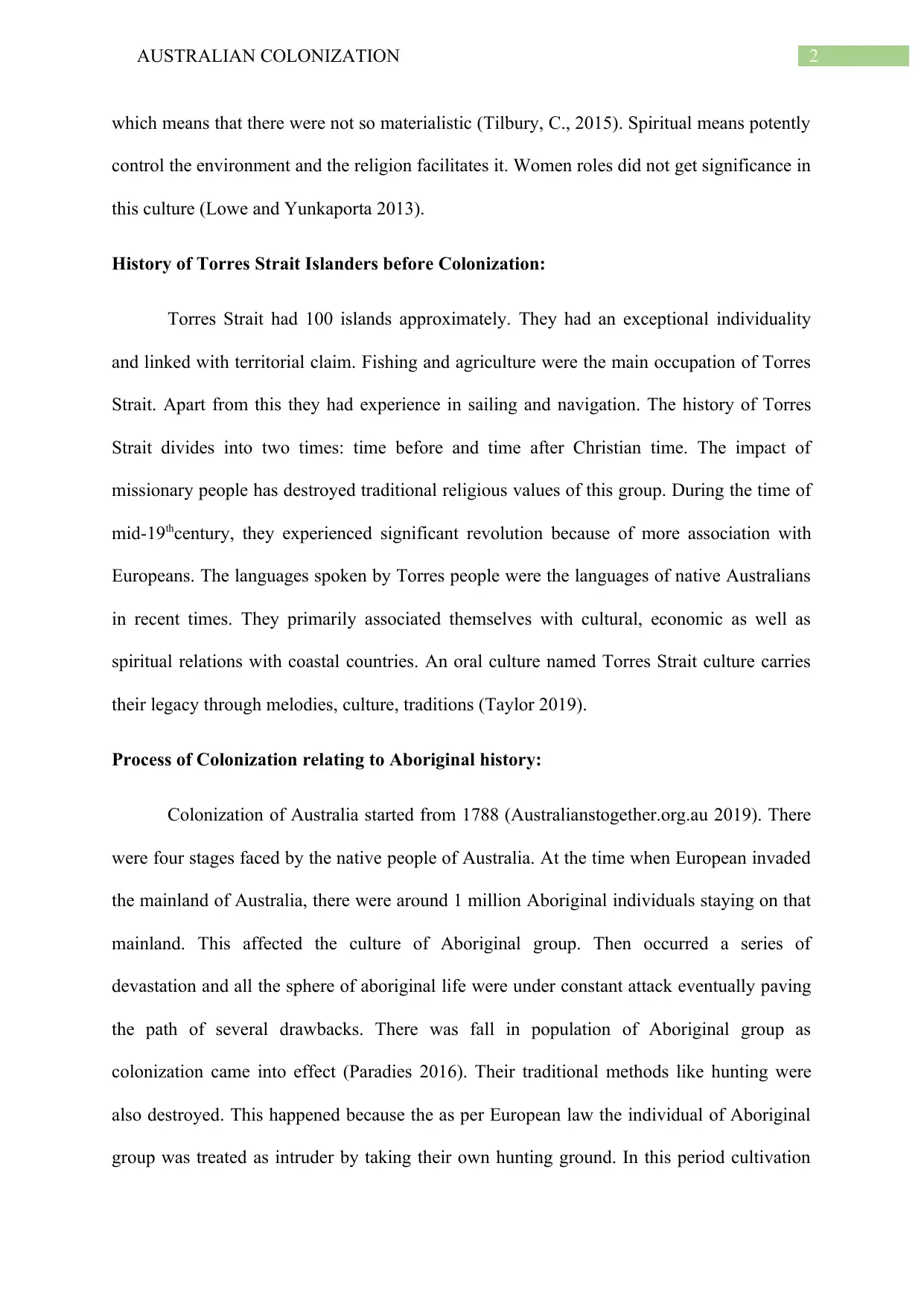
2AUSTRALIAN COLONIZATION
which means that there were not so materialistic (Tilbury, C., 2015). Spiritual means potently
control the environment and the religion facilitates it. Women roles did not get significance in
this culture (Lowe and Yunkaporta 2013).
History of Torres Strait Islanders before Colonization:
Torres Strait had 100 islands approximately. They had an exceptional individuality
and linked with territorial claim. Fishing and agriculture were the main occupation of Torres
Strait. Apart from this they had experience in sailing and navigation. The history of Torres
Strait divides into two times: time before and time after Christian time. The impact of
missionary people has destroyed traditional religious values of this group. During the time of
mid-19thcentury, they experienced significant revolution because of more association with
Europeans. The languages spoken by Torres people were the languages of native Australians
in recent times. They primarily associated themselves with cultural, economic as well as
spiritual relations with coastal countries. An oral culture named Torres Strait culture carries
their legacy through melodies, culture, traditions (Taylor 2019).
Process of Colonization relating to Aboriginal history:
Colonization of Australia started from 1788 (Australianstogether.org.au 2019). There
were four stages faced by the native people of Australia. At the time when European invaded
the mainland of Australia, there were around 1 million Aboriginal individuals staying on that
mainland. This affected the culture of Aboriginal group. Then occurred a series of
devastation and all the sphere of aboriginal life were under constant attack eventually paving
the path of several drawbacks. There was fall in population of Aboriginal group as
colonization came into effect (Paradies 2016). Their traditional methods like hunting were
also destroyed. This happened because the as per European law the individual of Aboriginal
group was treated as intruder by taking their own hunting ground. In this period cultivation
which means that there were not so materialistic (Tilbury, C., 2015). Spiritual means potently
control the environment and the religion facilitates it. Women roles did not get significance in
this culture (Lowe and Yunkaporta 2013).
History of Torres Strait Islanders before Colonization:
Torres Strait had 100 islands approximately. They had an exceptional individuality
and linked with territorial claim. Fishing and agriculture were the main occupation of Torres
Strait. Apart from this they had experience in sailing and navigation. The history of Torres
Strait divides into two times: time before and time after Christian time. The impact of
missionary people has destroyed traditional religious values of this group. During the time of
mid-19thcentury, they experienced significant revolution because of more association with
Europeans. The languages spoken by Torres people were the languages of native Australians
in recent times. They primarily associated themselves with cultural, economic as well as
spiritual relations with coastal countries. An oral culture named Torres Strait culture carries
their legacy through melodies, culture, traditions (Taylor 2019).
Process of Colonization relating to Aboriginal history:
Colonization of Australia started from 1788 (Australianstogether.org.au 2019). There
were four stages faced by the native people of Australia. At the time when European invaded
the mainland of Australia, there were around 1 million Aboriginal individuals staying on that
mainland. This affected the culture of Aboriginal group. Then occurred a series of
devastation and all the sphere of aboriginal life were under constant attack eventually paving
the path of several drawbacks. There was fall in population of Aboriginal group as
colonization came into effect (Paradies 2016). Their traditional methods like hunting were
also destroyed. This happened because the as per European law the individual of Aboriginal
group was treated as intruder by taking their own hunting ground. In this period cultivation
⊘ This is a preview!⊘
Do you want full access?
Subscribe today to unlock all pages.

Trusted by 1+ million students worldwide
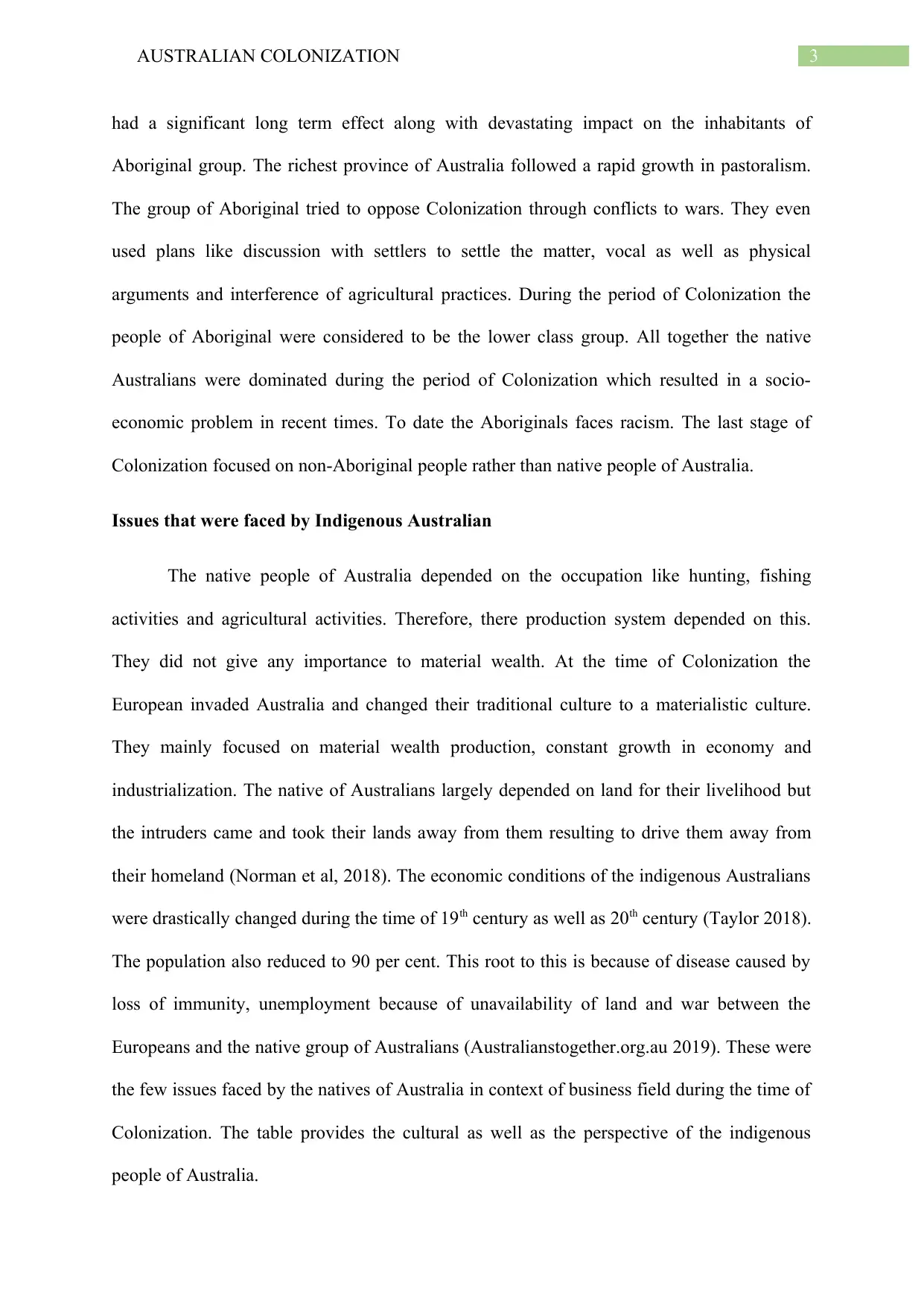
3AUSTRALIAN COLONIZATION
had a significant long term effect along with devastating impact on the inhabitants of
Aboriginal group. The richest province of Australia followed a rapid growth in pastoralism.
The group of Aboriginal tried to oppose Colonization through conflicts to wars. They even
used plans like discussion with settlers to settle the matter, vocal as well as physical
arguments and interference of agricultural practices. During the period of Colonization the
people of Aboriginal were considered to be the lower class group. All together the native
Australians were dominated during the period of Colonization which resulted in a socio-
economic problem in recent times. To date the Aboriginals faces racism. The last stage of
Colonization focused on non-Aboriginal people rather than native people of Australia.
Issues that were faced by Indigenous Australian
The native people of Australia depended on the occupation like hunting, fishing
activities and agricultural activities. Therefore, there production system depended on this.
They did not give any importance to material wealth. At the time of Colonization the
European invaded Australia and changed their traditional culture to a materialistic culture.
They mainly focused on material wealth production, constant growth in economy and
industrialization. The native of Australians largely depended on land for their livelihood but
the intruders came and took their lands away from them resulting to drive them away from
their homeland (Norman et al, 2018). The economic conditions of the indigenous Australians
were drastically changed during the time of 19th century as well as 20th century (Taylor 2018).
The population also reduced to 90 per cent. This root to this is because of disease caused by
loss of immunity, unemployment because of unavailability of land and war between the
Europeans and the native group of Australians (Australianstogether.org.au 2019). These were
the few issues faced by the natives of Australia in context of business field during the time of
Colonization. The table provides the cultural as well as the perspective of the indigenous
people of Australia.
had a significant long term effect along with devastating impact on the inhabitants of
Aboriginal group. The richest province of Australia followed a rapid growth in pastoralism.
The group of Aboriginal tried to oppose Colonization through conflicts to wars. They even
used plans like discussion with settlers to settle the matter, vocal as well as physical
arguments and interference of agricultural practices. During the period of Colonization the
people of Aboriginal were considered to be the lower class group. All together the native
Australians were dominated during the period of Colonization which resulted in a socio-
economic problem in recent times. To date the Aboriginals faces racism. The last stage of
Colonization focused on non-Aboriginal people rather than native people of Australia.
Issues that were faced by Indigenous Australian
The native people of Australia depended on the occupation like hunting, fishing
activities and agricultural activities. Therefore, there production system depended on this.
They did not give any importance to material wealth. At the time of Colonization the
European invaded Australia and changed their traditional culture to a materialistic culture.
They mainly focused on material wealth production, constant growth in economy and
industrialization. The native of Australians largely depended on land for their livelihood but
the intruders came and took their lands away from them resulting to drive them away from
their homeland (Norman et al, 2018). The economic conditions of the indigenous Australians
were drastically changed during the time of 19th century as well as 20th century (Taylor 2018).
The population also reduced to 90 per cent. This root to this is because of disease caused by
loss of immunity, unemployment because of unavailability of land and war between the
Europeans and the native group of Australians (Australianstogether.org.au 2019). These were
the few issues faced by the natives of Australia in context of business field during the time of
Colonization. The table provides the cultural as well as the perspective of the indigenous
people of Australia.
Paraphrase This Document
Need a fresh take? Get an instant paraphrase of this document with our AI Paraphraser
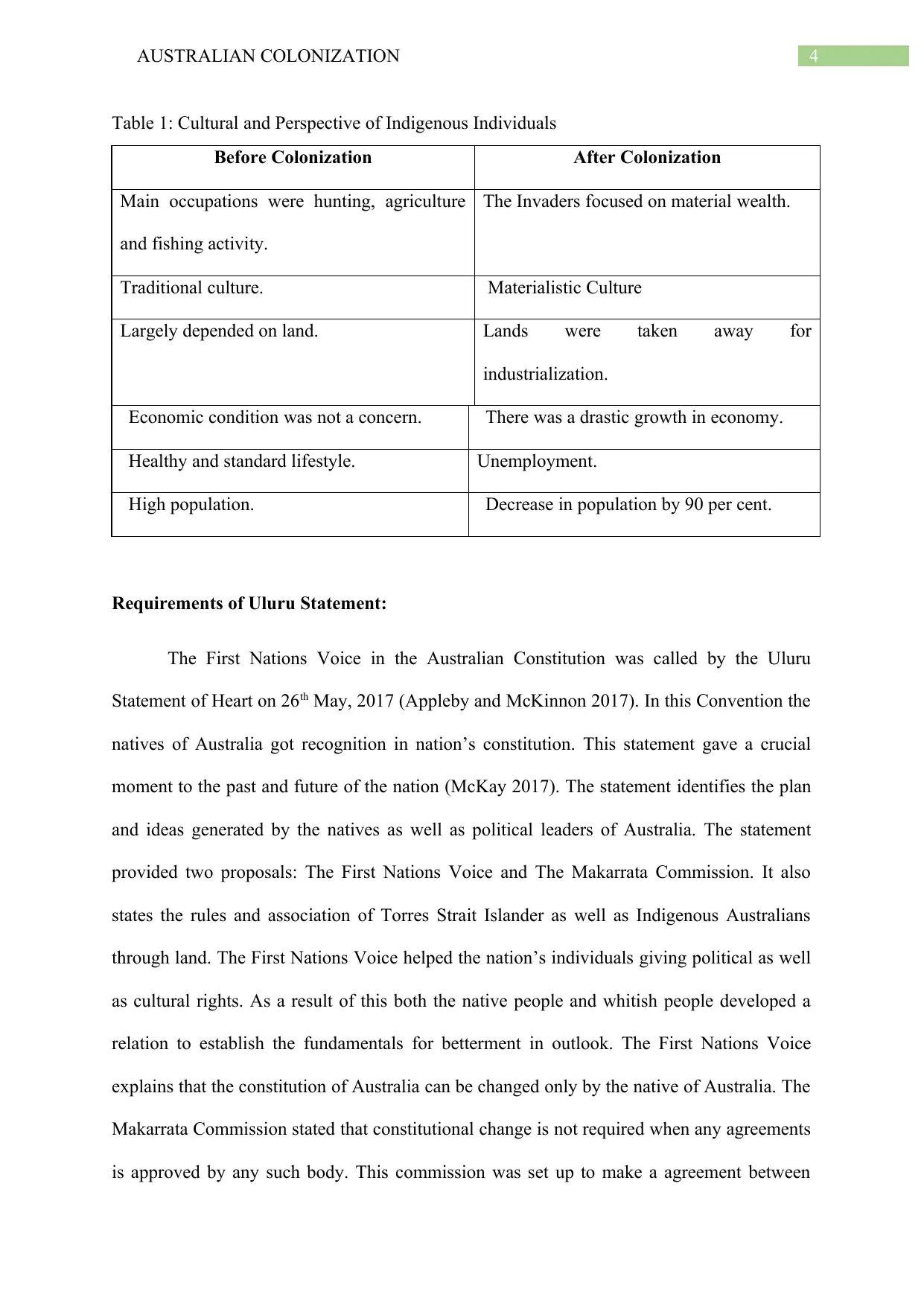
4AUSTRALIAN COLONIZATION
Table 1: Cultural and Perspective of Indigenous Individuals
Before Colonization After Colonization
Main occupations were hunting, agriculture
and fishing activity.
The Invaders focused on material wealth.
Traditional culture. Materialistic Culture
Largely depended on land. Lands were taken away for
industrialization.
Economic condition was not a concern. There was a drastic growth in economy.
Healthy and standard lifestyle. Unemployment.
High population. Decrease in population by 90 per cent.
Requirements of Uluru Statement:
The First Nations Voice in the Australian Constitution was called by the Uluru
Statement of Heart on 26th May, 2017 (Appleby and McKinnon 2017). In this Convention the
natives of Australia got recognition in nation’s constitution. This statement gave a crucial
moment to the past and future of the nation (McKay 2017). The statement identifies the plan
and ideas generated by the natives as well as political leaders of Australia. The statement
provided two proposals: The First Nations Voice and The Makarrata Commission. It also
states the rules and association of Torres Strait Islander as well as Indigenous Australians
through land. The First Nations Voice helped the nation’s individuals giving political as well
as cultural rights. As a result of this both the native people and whitish people developed a
relation to establish the fundamentals for betterment in outlook. The First Nations Voice
explains that the constitution of Australia can be changed only by the native of Australia. The
Makarrata Commission stated that constitutional change is not required when any agreements
is approved by any such body. This commission was set up to make a agreement between
Table 1: Cultural and Perspective of Indigenous Individuals
Before Colonization After Colonization
Main occupations were hunting, agriculture
and fishing activity.
The Invaders focused on material wealth.
Traditional culture. Materialistic Culture
Largely depended on land. Lands were taken away for
industrialization.
Economic condition was not a concern. There was a drastic growth in economy.
Healthy and standard lifestyle. Unemployment.
High population. Decrease in population by 90 per cent.
Requirements of Uluru Statement:
The First Nations Voice in the Australian Constitution was called by the Uluru
Statement of Heart on 26th May, 2017 (Appleby and McKinnon 2017). In this Convention the
natives of Australia got recognition in nation’s constitution. This statement gave a crucial
moment to the past and future of the nation (McKay 2017). The statement identifies the plan
and ideas generated by the natives as well as political leaders of Australia. The statement
provided two proposals: The First Nations Voice and The Makarrata Commission. It also
states the rules and association of Torres Strait Islander as well as Indigenous Australians
through land. The First Nations Voice helped the nation’s individuals giving political as well
as cultural rights. As a result of this both the native people and whitish people developed a
relation to establish the fundamentals for betterment in outlook. The First Nations Voice
explains that the constitution of Australia can be changed only by the native of Australia. The
Makarrata Commission stated that constitutional change is not required when any agreements
is approved by any such body. This commission was set up to make a agreement between
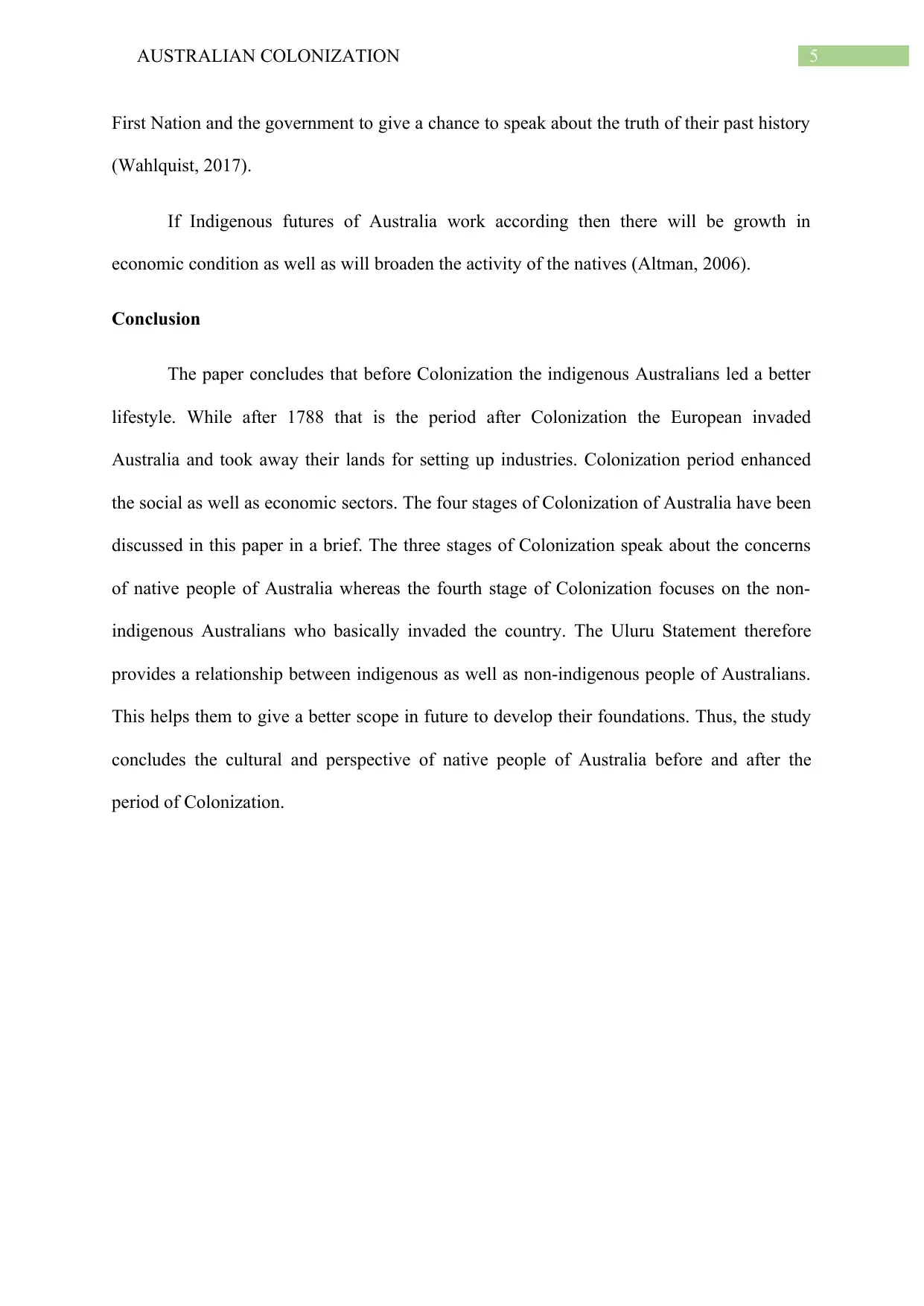
5AUSTRALIAN COLONIZATION
First Nation and the government to give a chance to speak about the truth of their past history
(Wahlquist, 2017).
If Indigenous futures of Australia work according then there will be growth in
economic condition as well as will broaden the activity of the natives (Altman, 2006).
Conclusion
The paper concludes that before Colonization the indigenous Australians led a better
lifestyle. While after 1788 that is the period after Colonization the European invaded
Australia and took away their lands for setting up industries. Colonization period enhanced
the social as well as economic sectors. The four stages of Colonization of Australia have been
discussed in this paper in a brief. The three stages of Colonization speak about the concerns
of native people of Australia whereas the fourth stage of Colonization focuses on the non-
indigenous Australians who basically invaded the country. The Uluru Statement therefore
provides a relationship between indigenous as well as non-indigenous people of Australians.
This helps them to give a better scope in future to develop their foundations. Thus, the study
concludes the cultural and perspective of native people of Australia before and after the
period of Colonization.
First Nation and the government to give a chance to speak about the truth of their past history
(Wahlquist, 2017).
If Indigenous futures of Australia work according then there will be growth in
economic condition as well as will broaden the activity of the natives (Altman, 2006).
Conclusion
The paper concludes that before Colonization the indigenous Australians led a better
lifestyle. While after 1788 that is the period after Colonization the European invaded
Australia and took away their lands for setting up industries. Colonization period enhanced
the social as well as economic sectors. The four stages of Colonization of Australia have been
discussed in this paper in a brief. The three stages of Colonization speak about the concerns
of native people of Australia whereas the fourth stage of Colonization focuses on the non-
indigenous Australians who basically invaded the country. The Uluru Statement therefore
provides a relationship between indigenous as well as non-indigenous people of Australians.
This helps them to give a better scope in future to develop their foundations. Thus, the study
concludes the cultural and perspective of native people of Australia before and after the
period of Colonization.
⊘ This is a preview!⊘
Do you want full access?
Subscribe today to unlock all pages.

Trusted by 1+ million students worldwide
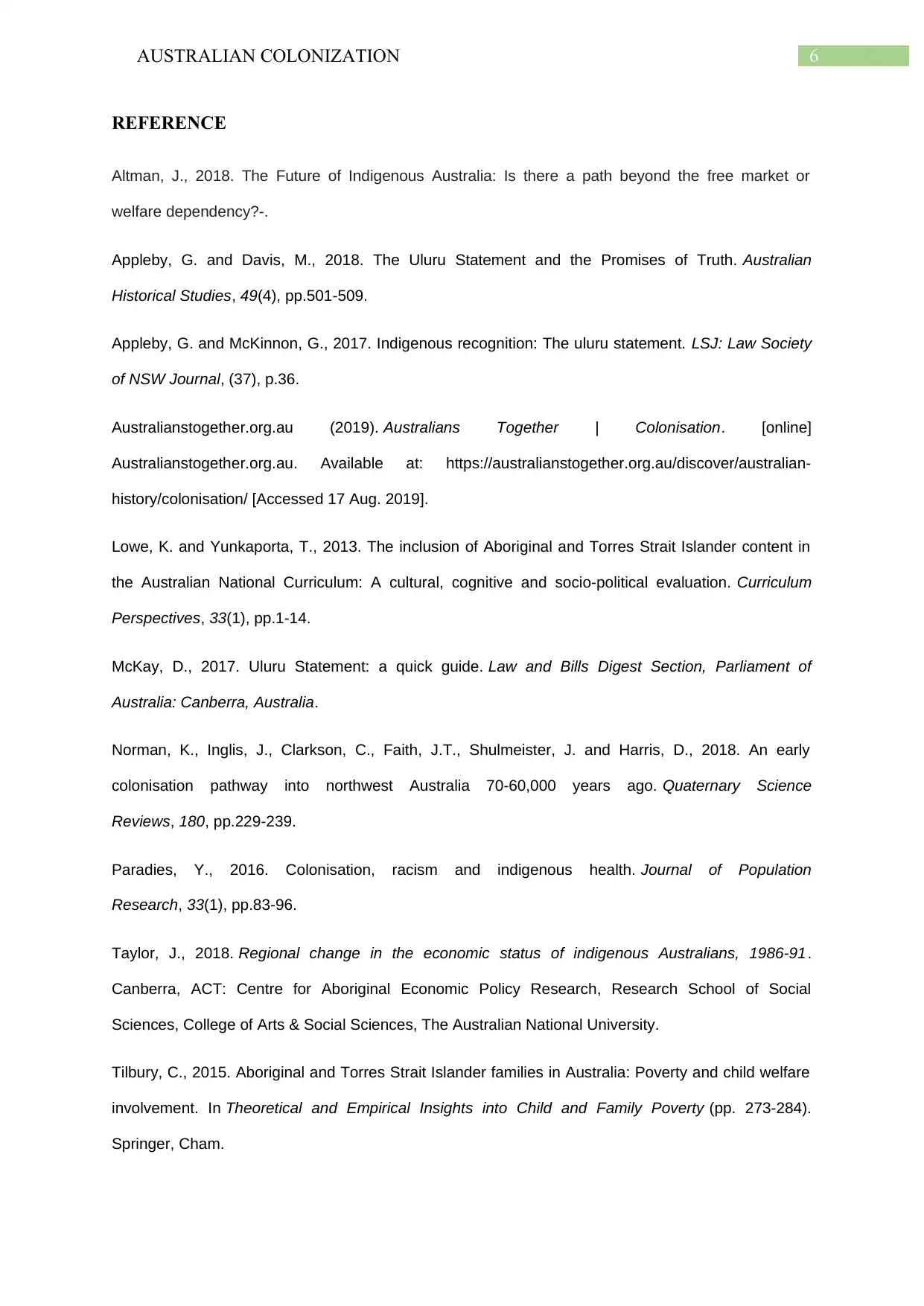
6AUSTRALIAN COLONIZATION
REFERENCE
Altman, J., 2018. The Future of Indigenous Australia: Is there a path beyond the free market or
welfare dependency?-.
Appleby, G. and Davis, M., 2018. The Uluru Statement and the Promises of Truth. Australian
Historical Studies, 49(4), pp.501-509.
Appleby, G. and McKinnon, G., 2017. Indigenous recognition: The uluru statement. LSJ: Law Society
of NSW Journal, (37), p.36.
Australianstogether.org.au (2019). Australians Together | Colonisation. [online]
Australianstogether.org.au. Available at: https://australianstogether.org.au/discover/australian-
history/colonisation/ [Accessed 17 Aug. 2019].
Lowe, K. and Yunkaporta, T., 2013. The inclusion of Aboriginal and Torres Strait Islander content in
the Australian National Curriculum: A cultural, cognitive and socio-political evaluation. Curriculum
Perspectives, 33(1), pp.1-14.
McKay, D., 2017. Uluru Statement: a quick guide. Law and Bills Digest Section, Parliament of
Australia: Canberra, Australia.
Norman, K., Inglis, J., Clarkson, C., Faith, J.T., Shulmeister, J. and Harris, D., 2018. An early
colonisation pathway into northwest Australia 70-60,000 years ago. Quaternary Science
Reviews, 180, pp.229-239.
Paradies, Y., 2016. Colonisation, racism and indigenous health. Journal of Population
Research, 33(1), pp.83-96.
Taylor, J., 2018. Regional change in the economic status of indigenous Australians, 1986-91.
Canberra, ACT: Centre for Aboriginal Economic Policy Research, Research School of Social
Sciences, College of Arts & Social Sciences, The Australian National University.
Tilbury, C., 2015. Aboriginal and Torres Strait Islander families in Australia: Poverty and child welfare
involvement. In Theoretical and Empirical Insights into Child and Family Poverty (pp. 273-284).
Springer, Cham.
REFERENCE
Altman, J., 2018. The Future of Indigenous Australia: Is there a path beyond the free market or
welfare dependency?-.
Appleby, G. and Davis, M., 2018. The Uluru Statement and the Promises of Truth. Australian
Historical Studies, 49(4), pp.501-509.
Appleby, G. and McKinnon, G., 2017. Indigenous recognition: The uluru statement. LSJ: Law Society
of NSW Journal, (37), p.36.
Australianstogether.org.au (2019). Australians Together | Colonisation. [online]
Australianstogether.org.au. Available at: https://australianstogether.org.au/discover/australian-
history/colonisation/ [Accessed 17 Aug. 2019].
Lowe, K. and Yunkaporta, T., 2013. The inclusion of Aboriginal and Torres Strait Islander content in
the Australian National Curriculum: A cultural, cognitive and socio-political evaluation. Curriculum
Perspectives, 33(1), pp.1-14.
McKay, D., 2017. Uluru Statement: a quick guide. Law and Bills Digest Section, Parliament of
Australia: Canberra, Australia.
Norman, K., Inglis, J., Clarkson, C., Faith, J.T., Shulmeister, J. and Harris, D., 2018. An early
colonisation pathway into northwest Australia 70-60,000 years ago. Quaternary Science
Reviews, 180, pp.229-239.
Paradies, Y., 2016. Colonisation, racism and indigenous health. Journal of Population
Research, 33(1), pp.83-96.
Taylor, J., 2018. Regional change in the economic status of indigenous Australians, 1986-91.
Canberra, ACT: Centre for Aboriginal Economic Policy Research, Research School of Social
Sciences, College of Arts & Social Sciences, The Australian National University.
Tilbury, C., 2015. Aboriginal and Torres Strait Islander families in Australia: Poverty and child welfare
involvement. In Theoretical and Empirical Insights into Child and Family Poverty (pp. 273-284).
Springer, Cham.
Paraphrase This Document
Need a fresh take? Get an instant paraphrase of this document with our AI Paraphraser
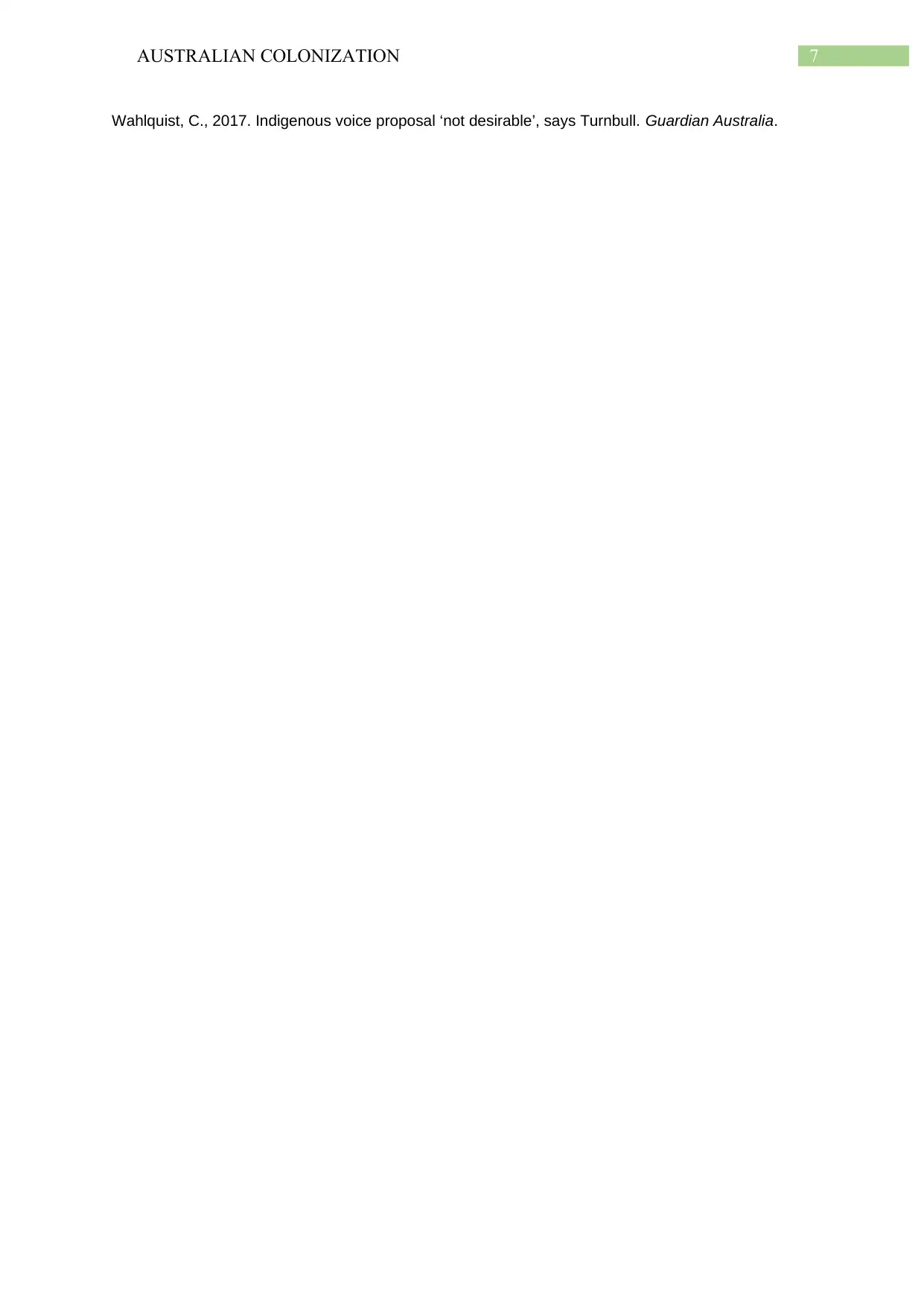
7AUSTRALIAN COLONIZATION
Wahlquist, C., 2017. Indigenous voice proposal ‘not desirable’, says Turnbull. Guardian Australia.
Wahlquist, C., 2017. Indigenous voice proposal ‘not desirable’, says Turnbull. Guardian Australia.
1 out of 8
Related Documents
Your All-in-One AI-Powered Toolkit for Academic Success.
+13062052269
info@desklib.com
Available 24*7 on WhatsApp / Email
![[object Object]](/_next/static/media/star-bottom.7253800d.svg)
Unlock your academic potential
Copyright © 2020–2025 A2Z Services. All Rights Reserved. Developed and managed by ZUCOL.





